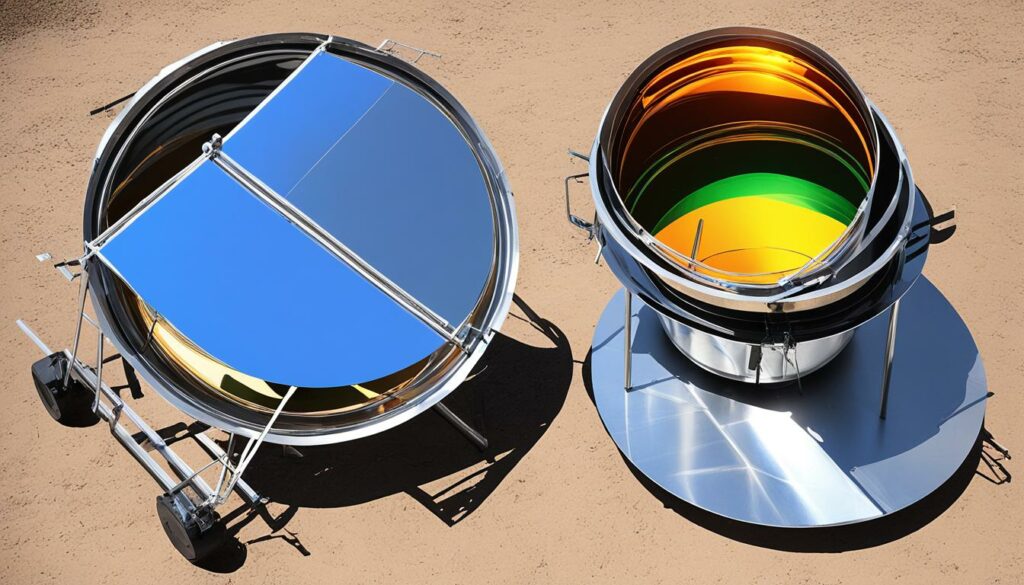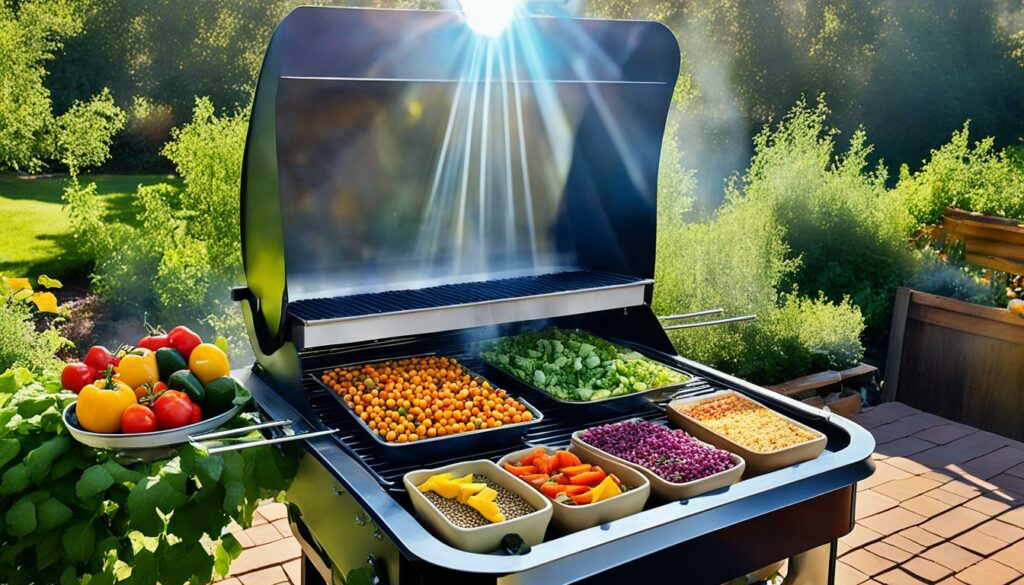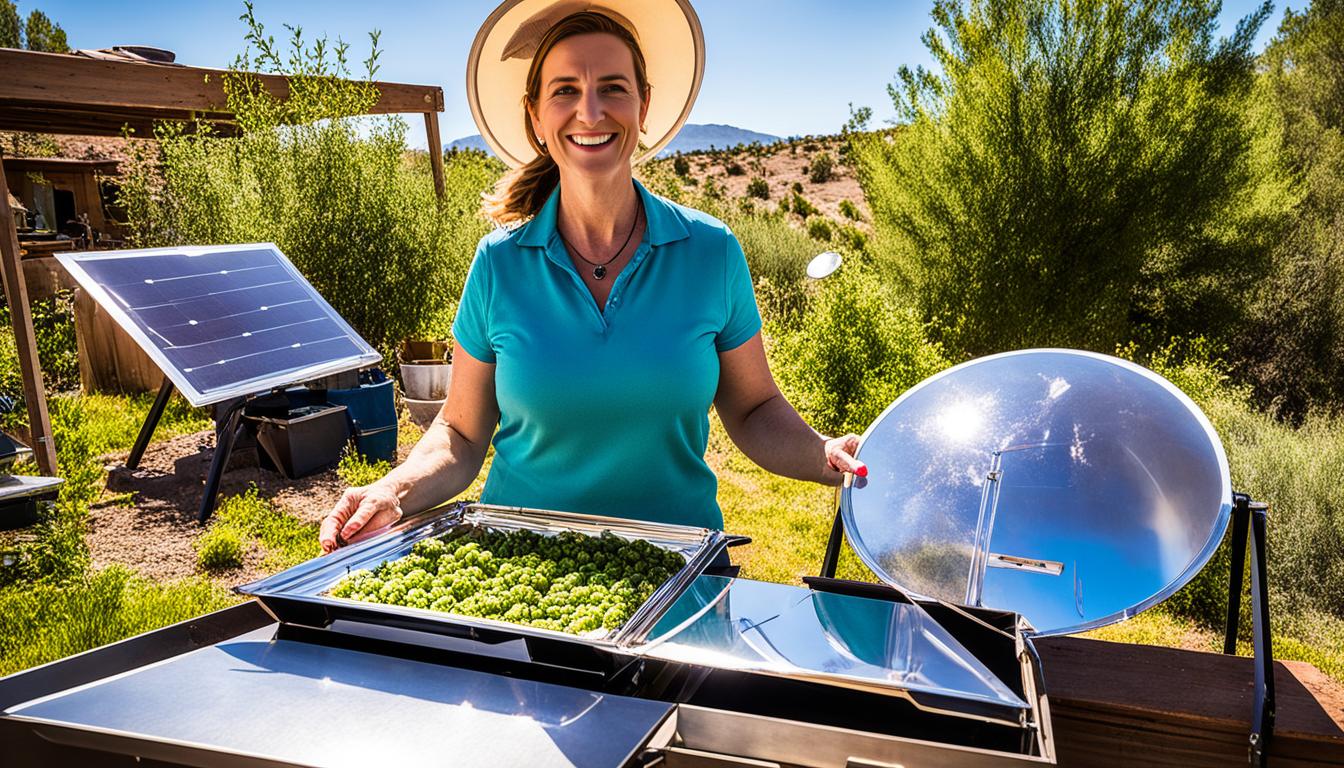Using the sun’s energy for cooking is a green way to cook. It uses the sun’s heat to cook food in a special box. This method doesn’t need electricity, gas, or wood.
It’s cheap and doesn’t harm the air or trees. People in poor countries and small towns like this way of cooking a lot.
Key Takeaways
- Solar cooking is a sustainable and eco-friendly cooking method that uses the sun’s energy to heat food.
- It eliminates the need for electricity, gas, or burning organic materials, reducing air pollution and deforestation.
- Solar cooking is an accessible and inexpensive alternative, especially in areas with limited access to traditional energy sources.
- Solar cooking techniques include box, panel, and parabolic solar cookers, each with unique features and benefits.
- Building your own solar cooker can be a rewarding and educational experience.
Introduction to Solar Cooking
Solar cooking uses the sun’s power to cook food. It’s a green way to make meals. It has many benefits over traditional cooking methods. This makes it great for those who care about the planet.
Benefits of Solar Cooking
Solar cooking is good because it uses clean energy from the sun. It doesn’t need electricity, gas, or other fuels. This means no harmful emissions or greenhouse gases.
It’s also cost-effective. After buying a solar cooker, you don’t spend much on fuel or bills. This makes it a smart choice for your wallet.
Comparison to Traditional Cooking Methods
Solar cooking is different from old ways of cooking. It cooks food slowly but you don’t have to watch it. You can cook many dishes this way.
Solar cookers get hot enough to cook meat, veggies, and even baked goods. They heat up to 200°F to 300°F.
| Feature | Solar Cooking | Traditional Cooking |
|---|---|---|
| Energy Source | Renewable (Sun) | Fossil Fuels (Electricity, Gas) |
| Cooking Time | Slower | Faster |
| Emissions | Zero | High |
| Operating Cost | Low | High |
Knowing the benefits of solar cooking helps people choose this green and affordable way to cook.
Types of Solar Cookers
There are three main types of solar cookers: box, panel, and parabolic. Each has its own benefits for different cooking needs and likes.
Box Solar Cookers
Box solar cookers are easy to use. They use a reflective wall to send sunlight into an insulated box. The food cooks well without using much energy.
Panel Solar Cookers
Panel solar cookers are like box ones but better. They have more reflective walls. These walls focus the sun’s rays on a pot, cooking food faster.
Parabolic Solar Cookers
Parabolic solar cookers cook the fastest. They have curved surfaces that focus sunlight intensely on a point. This makes cooking quick. But, they need to be aimed right to follow the sun all day.
| Type of Solar Cooker | Cooking Time | Ease of Use | Cost |
|---|---|---|---|
| Box Solar Cooker | Slower | Easiest | Lowest |
| Panel Solar Cooker | Moderate | Moderate | Mid-range |
| Parabolic Solar Cooker | Fastest | Most Challenging | Highest |
Choosing a solar cooker depends on how fast you want to cook, how easy it is to use, and your budget. All solar cookers are good for the planet and save energy.
Solar Cooking Techniques
Learning how to solar cook takes a lot of knowledge. You need to make sure your solar cooker faces the sun. Move the reflector or the cooker to keep getting lots of sun. This makes sure your food cooks well.
Cooking with solar cookers takes longer than usual. It depends on the cooker type, the weather, and what you’re cooking. Always check the cooker’s temperature and the food inside. This keeps your food safe and cooked right.
- Align the solar cooker to directly face the sun.
- Adjust the reflector or position of the cooker as needed to maintain optimal sun exposure.
- Allow sufficient time for the food to cook, as solar cooking typically takes longer than conventional methods.
- Regularly check the internal temperature of the solar cooker and the food to ensure proper cooking and food safety.
By learning these key solar cooking techniques, you can make great meals using the sun’s energy. Start your solar cooking adventure today and feel the sun’s power.
“Solar cooking is not just a way to prepare food – it’s a way to connect with the natural world and appreciate the power of the sun.”
Components of a Solar Cooker
A solar cooker has three main parts: reflectors, a dark interior, and insulation. These parts work together to catch the sun’s energy. They turn it into heat for cooking in an eco-friendly way.
Reflectors
Reflectors are key in a solar cooker. They focus the sun’s rays onto the cooking area. Made of materials like foil or mirrors, they send more sun rays to the cooking surface.
By placing and shaping the reflectors right, the cooker gets more sun energy. This makes the inside hotter for cooking.
Dark Interior and Cooking Pots
The inside of a solar cooker absorbs solar radiation. It has a dark surface to turn sun energy into heat. This heats up the cooking pots.
Using dark pots helps too. They’re made to cook well in the sun.
Insulation Materials
Keeping heat in the cooker is important for cooking well. Insulation like cardboard or newspaper lines the cooker’s walls and lid. It keeps the heated air from escaping.
This keeps the cooking area at the right temperature. Food cooks slowly and evenly with the sun’s energy.
| Solar Cooker Component | Purpose | Examples |
|---|---|---|
| Reflectors | Concentrate and direct solar radiation into the cooking area | Foil, mirrors |
| Dark Interior and Cooking Pots | Absorb and convert solar energy into heat | Black paint, black pots |
| Insulation Materials | Retain heat inside the cooker | Cardboard, newspaper |
Knowing how a solar cooker works helps users get the most out of it. This way, they can enjoy cooking with the sun’s power.

Building Your Own Solar Cooker
Making your own solar cooker is fun and good for the planet. You can use the sun’s power to cook food without using much energy. If you want to learn how to build a solar cooker, try DIY solar cooker projects, or start with solar cooker construction, you can find everything you need.
Materials Needed
Building a solar cooker is easy because you can use things you already have. Items like cardboard boxes, aluminum foil, plastic wrap, and dark pots can make a solar cooker. With these things, you can start your DIY solar cooker project right away.
Step-by-Step Instructions
- Get a strong cardboard box that’s big enough for your cooking.
- Put aluminum foil inside the box to reflect the sun’s rays.
- Put a clear plastic sheet on top to trap the heat inside.
- Put your dark pots or pans inside to catch the sun’s rays.
- Wrap the box with insulation or bubble wrap to keep it warm.
- Put your solar cooker in a sunny spot and adjust it to catch the most sun.
Just follow these easy steps to make your own solar cooker. You can use online guides and tutorials to help you with the solar cooker construction. This makes it easy for anyone to try it.
Solar Cooking Recipes
Use the sun’s power to make tasty solar-cooked dishes. Solar cookers let you make many yummy meals, like savory casseroles and sweet treats. These recipes are great for both experts and beginners in solar cooking.
Zucchini Quiche
Make a classic zucchini quiche in your solar oven. Put shredded zucchini, eggs, and cheese in a pie crust. Let the sun cook it for about 2 hours. You’ll get a golden, fluffy quiche perfect for lunch or as a side.
Pot Roast with Vegetables
Enjoy a slow-cooked pot roast with veggies that’s both comforting and tasty. Put the roast, potatoes, carrots, and onions in your solar cooker. Let the sun cook it for 3-4 hours. You’ll get a roast that’s tender and full of flavor.
Oatmeal Squares
Start your day with solar-baked oatmeal squares. Mix oats, nuts, dried fruit, and a bit of sweetener. Let the sun make them golden and chewy. Enjoy these with your morning coffee for a healthy breakfast.
Solar cooking lets you try new recipes. Use the sun to make solar cooking recipes, solar oven recipes, and solar cooker recipes that are tasty and good for the planet. Try different ingredients and methods to find your favorite solar dishes.

Solar Cooking for Camping and Traveling
Solar cooking is great for outdoor lovers, especially those who camp and travel. It uses the sun’s power to cook food. This means no need for electricity, gas, or other fuels.
Solar ovens cook food slowly and gently. This is perfect for dishes that don’t need constant watching. You can make many tasty meals with solar cooking, like stews and desserts.
“Solar cooking is a game-changer for outdoor adventures. It’s clean, efficient, and allows me to enjoy freshly cooked meals without the hassle of traditional cooking methods.”
Portable solar cookers are very useful. They are small and light, making them easy to carry. This lets campers and travelers cook with the sun anywhere they go. Solar cooking is a fun and useful way to cook during trips.
| Feature | Benefit |
|---|---|
| Portable and Lightweight Design | Easy to transport and set up, perfect for camping and traveling |
| Slow Cooking Process | Ideal for dishes that can be left unattended, like stews and casseroles |
| No Fuel or Electricity Required | Sustainable and eco-friendly cooking option for outdoor adventures |
Planning a camping trip or a long road trip? Solar cooking for camping and solar cooking for travel can change the game. Use the sun’s power to make tasty meals anywhere you go.
Involving Kids in Solar Cooking
Solar cooking is fun and teaches kids a lot. Making a simple solar cooker shows how the sun cooks food. It teaches about kids solar cooking, renewable energy, and why we should care for our planet.
Educational Benefits
Doing educational solar cooking projects helps kids learn a lot. They get to make and use a solar cooker. This helps them understand:
- How solar energy works for cooking
- Why we need renewable energy and a green planet
- How science works through experiments and watching closely
- How to solve problems and think critically with their solar cookers
Kid-Friendly Solar Cooking Projects
There are many fun kid-friendly solar cooking projects. Kids love these activities:
- Making s’mores in a solar oven
- Baking cookies or simple recipes with a solar cooker
- Building a solar-powered robot or small device
- Trying out different materials to make a solar cooker work better
These activities teach kids about solar energy and boost their creativity and problem-solving.
“Engaging kids in solar cooking projects is a fantastic way to inspire their curiosity and teach them about renewable energy and environmental sustainability.”
Advantages and Disadvantages of Solar Cooking
Solar cooking is great because it’s clean and uses the sun’s energy. It doesn’t pollute the air or harm trees. Plus, it saves money because you don’t need to buy fuel or electricity.
Using solar cookers is easy and they don’t need much upkeep. This is good news for people who don’t have easy access to other cooking ways.
But, solar cooking has some downsides. It works best when the sun is out. On cloudy days, it cooks food slower. This might be a problem for some folks.
Also, solar cookers can’t cook as much food as regular ovens. They’re better for small meals or special dishes. This could be a challenge for big families or groups.
Even with its flaws, solar cooking has big pluses. It’s good for the planet, saves money, and is easy to use. As technology gets better, solar cooking could become even more useful.
| Advantages of Solar Cooking | Disadvantages of Solar Cooking |
|---|---|
|
|
Solar cooking isn’t perfect for everyone. But, it’s a great choice for those wanting a green and wallet-friendly way to cook. As technology gets better, solar cooking could become even more appealing.
Sustainability and Environmental Impact
Solar cooking uses the sun’s energy in a green way. It doesn’t burn fossil fuels or organic stuff like traditional cooking does. This makes it good for the planet.
Using the sun to cook food cuts down on energy use. This means less electricity, gas, and other energy sources needed. It’s a big step towards living sustainably and using clean energy.
Solar cooking also means no harmful gases or pollution. This is great in places where cooking with wood or charcoal harms the air and forests. Solar cooking helps keep nature safe and clean.
| Environmental Impact | Traditional Cooking | Solar Cooking |
|---|---|---|
| Greenhouse Gas Emissions | High | Negligible |
| Air Pollution | Significant | None |
| Deforestation | Contributes to | No impact |
| Carbon Footprint | High | Low |
Using solar cooking helps us all be more eco-friendly. It’s a big step towards fighting climate change and saving resources. As we face these big challenges, solar cooking can lead us to a greener future.
“Solar cooking is a game-changer in the quest for sustainable living. It’s a simple yet powerful solution that reduces our environmental footprint while harnessing the abundant energy of the sun.”
Conclusion
Solar cooking is a green way to cook that uses the sun’s energy. It lets people make many tasty dishes without using a lot of fuel or electricity. This helps lower our carbon footprint and makes cooking clean and easy.
More people are learning about solar cooking and using it. It’s becoming key in the move to renewable energy and living green. Solar cookers are easy to use and cook food well. They don’t need expensive or dirty energy, making them great for those wanting to live greener.
In short, solar cooking changes how we use energy. It lets us control our energy use, cut down on pollution, and enjoy cooking with the sun. As we face big challenges like climate change and energy issues, solar cooking shows us how new ideas can make a big difference for a better future.
FAQ
What are the main types of solar cookers?
How do you position and operate a solar cooker?
What are the key components of a solar cooker?
Can you build your own solar cooker?
What types of dishes can be cooked in a solar cooker?
Can solar cookers be used for outdoor activities like camping?
Can solar cooking be an educational activity for children?
What are the advantages and disadvantages of solar cooking?
How is solar cooking considered a sustainable cooking method?
Source Links
- Solar Cooking – UF/IFAS Extension: Solutions for Your Life – https://sfyl.ifas.ufl.edu/archive/hot_topics/sustainable_living/solar_cooking.shtml
- PDF – https://alaskarenewableenergy.org/wp-content/uploads/2020/07/Solar-Cooker-Design-Challenge-FINAL.pdf
- Your Guide to Cooking with Solar Energy | LGCY Power – https://www.lgcypower.com/cooking-using-solar-power/
